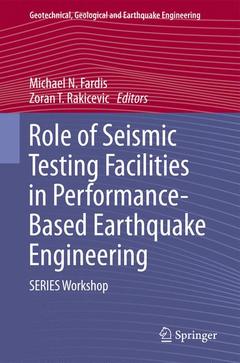Description
Role of Seismic Testing Facilities in Performance-Based Earthquake Engineering, 2012
SERIES Workshop
Coll. Geotechnical, Geological and Earthquake Engineering, Vol. 22
Coordinators: Fardis Michael N., Rakicevic Zoran T.
Language: French
Subjects for Role of Seismic Testing Facilities in Performance-Based...:
Publication date: 11-2013
386 p. · 15.5x23.5 cm · Paperback
Publication date: 10-2011
386 p. · 15.5x23.5 cm · Hardback
Description
/li>Contents
/li>Comment
/li>
Nowadays research in earthquake engineering is mainly experimental and in large-scale; advanced computations are integrated with large-scale experiments, to complement them and extend their scope, even by coupling two different but simultaneous tests. Earthquake engineering cannot give answers by testing and qualifying few, small typical components or single large prototypes. Besides, the large diversity of Civil Engineering structures does not allow drawing conclusions from only a few tests; structures are large and their seismic response and performance cannot be meaningfully tested in an ordinary lab or in the field. So, seismic testing facilities should be much larger than in other scientific fields; their staff has to be resourceful, devising intelligent ways to carry out simultaneously different tests and advanced computations. To better serve such a mission European testing facilities and researchers in earthquake engineering have shared their resources and activities in the framework of the European project SERIES, combining their research and jointly developing advanced testing and instrumentation techniques that maximize testing capabilities and increase the value of the tests. This volume presents the first outcomes of the SERIES and its contribution towards Performance-based Earthquake Engineering, i.e., to the most important development in Earthquake Engineering of the past three decades. The concept and the methodologies for performance-based earthquake engineering have now matured. However, they are based mainly on analytical/numerical research; large-scale seismic testing has entered the stage recently. The SERIES Workshop in Ohrid (MK) in Sept. 2010 pooled together the largest European seismic testing facilities, Europe?s best experts in experimental earthquake engineering and select experts from the USA, to present recent research achievements and to address future developments.
Audience: This volume will be ofinterest to researchers and advanced practitioners in structural earthquake engineering, geotechnical earthquake engineering, engineering seismology, and experimental dynamics, including seismic qualification.
Preface.- 1 How Can Experimental Testing Contribute to Performance-Based Earthquake Engineering; F. Taucer, A. Pinto.- 2 Earthquake and Large Structures Testing at the Bristol Laboratory for Advanced Dynamics Engineering; M.S. Dietz et al.- 3 Structural and Behaviour Constraints of Shaking Table Experiments; Z.T. Rakicevic, A. Bogdanovic, D. Jurukovski.- 4 Eucentre TREES Lab: Laboratory for Training and Research in Earthquake Engineering and Seismology; S. Peloso, A. Pavese, C. Casarotti.- 5 Cross-Facility Validation of Dynamic Centrifuge Testing; U. Cilingir et al.- 6 Towards a European High Capacity Facility for Advanced Seismic Testing; F. Marazzi, I. Politopoulos, A. Pavese.- 7 Performance Requirements of Actuation Systems for Dynamic Testing in the European Earthquake Engineering Laboratories; L. Dihoru et al.- 8 Model Container Design for Soil-Structure Interaction Studies; S. Bhattacharya et al.- 9 Computer Vision System for Monitoring in Dynamic Structural Testing; F. Lunghi et al.- 10 Quality Needs of IT Infrastructure in Modern Earthquake Engineering Laboratories; M.H. Zaharia, G.M. Atanasiu.- 11 Use of Large Numerical Models and High Performance Computers in Geographically Distributed Seismic Tests; F. Obón Santacana, U.E. Dorka.- 12 Shaking Table Testing of Models of Historic Buildings and Monuments - IZIIS' Experience; V. Shendova.- 13 Dynamic Behaviour of Reinforced Soils -Theoretical Modelling and Shaking Table Experiments; J. Soubestre et al.- 14 Evaluation and Impact of Qualification of Experimental Facilities in Europe; M. Zola, C.A. Taylor.- 15 Qualification of Large Testing Facilities in Earthquake Engineering Research; Ö. Kurç et al.- 16 Performance Based Seismic Qualification of Large-Class Building Equipment: AnImplementation Perspective; J. Gatscher.- 17 Experimental Evaluation of the Seismic Performance of Steel Buildings with Passive Dampers Using Real-Time Hybrid Simulation; T.L. Karavasilis et al.- 18 Experimental Investigation of the Seismic Behaviour of Precast Structures with Pinned Beam-to-Column Connections; I.N. Psycharis, H.P. Mouzakis, P.G. Carydis.- 19 Experimental Investigation of the Progressive Collapse of a Steel Special Moment-Resisting Frame and a Post-Tensioned Energy-Dissipating Frame; A. Tsitos, G. Mosqueda.- Index.




